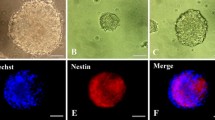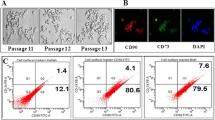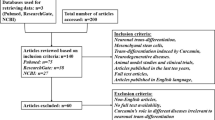Abstract
The role of resveratrol (RV) as a neuroprotectant is well recognized, and cellular molecules involved in imparting the physiological effect have been well illustrated. However, some ambiguity still prevails as the specific receptor, and downstream signaling molecules are not yet clearly stated. So, we investigated the signaling pathway(s) involved in its cellular protection in the human umbilical cord blood mesenchymal stem cell (hUCB-MSC) derived neuronal cells. The mesenchymal stem cells were exposed to various concentrations (10, 100, 1000 μM) of monocrotophos (MCP), a known developmental neurotoxic organophosphate pesticide, for a period of 24 h. The MAPK signaling pathways (JNK, p38, and ERK) known to be associated with MCP-induced damages were also taken into consideration to identify the potential connection. The biological safe dose of RV (10 μM) shows a significant restoration in the MCP-induced alterations. Under the specific growth conditions, RV exposure was found to promote neuronal differentiation in the hUCB-MSCs. The exposure of cells to a specific pharmacological inhibitor (LY294002) of PI3K confirms the significant involvement of PI3K-mediated pathway in the ameliorative responses of RV against MCP exposure. Our data identifies the substantial role of RV in the restoration of MCP-induced cellular damages, thus proving to have a therapeutic potential against organophosphate pesticide-induced neurodegeneration.









Similar content being viewed by others
References
Moser VC (2011) Functional assays for neurotoxicity testing. Toxicol Pathol 39(1):36–45
Cannon JR, Greenamyre JT (2011) The role of environmental exposures in neurodegeneration and neurodegenerative diseases. Toxicol Sci: p. kfr239
Drachman DA (2006) Aging of the brain, entropy, and Alzheimer disease. Neurology 67(8):1340–1352
Roberts RA, Aschner M, Calligaro D, Guilarte TR, Hanig JP, Herr DW, Hudzik TJ, Jeromin A et al (2015) Translational biomarkers of neurotoxicity: a Health and Environmental Sciences Institute perspective on the way forward. Toxicol Sci 148(2):332–340
Moreno-Banda G, Blanco-Muñoz J, Lacasaña M, Rothenberg SJ, Aguilar-Garduño C, Gamboa R, Pérez-Méndez O (2009) Maternal exposure to floricultural work during pregnancy, PON1 Q192R polymorphisms and the risk of low birth weight. Sci Total Environ 407(21):5478–5485
Pilkington A, Buchanan D, Jamal GA, Gillham R, Hansen S, Kidd M, Hurley JF, Soutar CA (2001) An epidemiological study of the relations between exposure to organophosphate pesticides and indices of chronic peripheral neuropathy and neuropsychological abnormalities in sheep farmers and dippers. Occup Environ Med 58(11):702–710
Slotkin TA, Seidler FJ (2012) Developmental neurotoxicity of organophosphates targets cell cycle and apoptosis, revealed by transcriptional profiles in vivo and in vitro. Neurotoxicol Teratol 34(2):232–241
Kashyap MP, Singh AK, Kumar V, Tripathi VK, Srivastava RK, Agrawal M, Khanna VK, Yadav S et al (2011) Monocrotophos induced apoptosis in PC12 cells: role of xenobiotic metabolizing cytochrome P450s. PLoS One 6(3):e17757
Pervaiz S, Holme AL (2009) Resveratrol: its biologic targets and functional activity. Antioxid Redox Signal 11(11):2851–2897
Soleas GJ, Diamandis EP, Goldberg DM (1997) Resveratrol: a molecule whose time has come? And gone? Clin Biochem 30(2):91–113
Rege SD et al (2014) Neuroprotective effects of resveratrol in Alzheimer disease pathology. Front Aging Neurosci 6(218):1–12
Menard C, Bastianetto S, Quirion R (2013) Neuroprotective effects of resveratrol and epigallocatechin gallate polyphenols are mediated by the activation of protein kinase C gamma. Front Cell Neurosci 7:281
Bonda DJ, Lee HG, Camins A, Pallàs M, Casadesus G, Smith MA, Zhu X (2011) The sirtuin pathway in ageing and Alzheimer disease: mechanistic and therapeutic considerations. The Lancet Neurology 10(3):275–279
Granzotto A, Zatta P (2011) Resveratrol acts not through anti-aggregative pathways but mainly via its scavenging properties against Aβ and Aβ-metal complexes toxicity. PLoS One 6(6):e21565
Granzotto A, Zatta P (2014) Resveratrol and Alzheimer’s disease: message in a bottle on red wine and cognition. Front Aging Neurosci 6:95
Neirinckx V, Coste C, Rogister B, Wislet-Gendebien S (2013) Concise review: adult mesenchymal stem cells, adult neural crest stem cells, and therapy of neurological pathologies: a state of play. Stem Cells Transl Med 2(4):284–296
Kashyap MP, Kumar V, Singh AK, Tripathi VK, Jahan S, Pandey A, Srivastava RK, Khanna VK et al (2015) Differentiating neurons derived from human umbilical cord blood stem cells work as a test system for developmental neurotoxicity. Mol Neurobiol 51(2):791–807
Uranga RM, Katz S, Salvador GA (2013) Enhanced phosphatidylinositol 3-kinase (PI3K)/Akt signaling has pleiotropic targets in hippocampal neurons exposed to iron-induced oxidative stress. J Biol Chem 288(27):19773–19784
Bonni A, Brunet A, West AE, Datta SR, Takasu MA, Greenberg ME (1999) Cell survival promoted by the Ras-MAPK signaling pathway by transcription-dependent and-independent mechanisms. Science 286(5443):1358–1362
Thomas GM, Huganir RL (2004) MAPK cascade signalling and synaptic plasticity. Nat Rev Neurosci 5(3):173–183
Liu M-H, Yuan C, He J, Tan TP, Wu SJ, Fu HY, Liu J, Yu S et al (2015) Resveratrol protects PC12 cells from high glucose-induced neurotoxicity via PI3K/Akt/FoxO3a pathway. Cell Mol Neurobiol 35(4):513–522
Singh N, Agrawal M, Doré S (2013) Neuroprotective properties and mechanisms of resveratrol in in vitro and in vivo experimental cerebral stroke models. ACS Chem Neurosci 4(8):1151–1162
Jahan S et al (2017) PKA-GSK3β and β-catenin signaling play a critical role in trans-resveratrol mediated neuronal differentiation in human cord blood stem cells. Molecular Neurobiology: p. 1–12
Pallàs M, Porquet D, Vicente A, Sanfeliu C (2013) Resveratrol: new avenues for a natural compound in neuroprotection. Curr Pharm Des 19(38):6726–6731
Jahan S, Kumar D, Kumar A, Rajpurohit CS, Singh S, Srivastava A, Pandey A, Pant AB (2017) Neurotrophic factor mediated neuronal differentiation of human cord blood mesenchymal stem cells and their applicability to assess the developmental neurotoxicity. Biochem Biophys Res Commun 482(4):961–967
Gilden RC, Huffling K, Sattler B (2010) Pesticides and health risks. J Obstet Gynecol Neonatal Nurs 39(1):103–110
Whyatt, R.M., et al., Within-and between-home variability in indoor-air insecticide levels during pregnancy among an inner-city cohort from New York City. Environmental health perspectives, 2007: p. 383–389
Kazi AI, Oommen A (2012) Monocrotophos induced oxidative damage associates with severe acetylcholinesterase inhibition in rat brain. Neurotoxicology 33(2):156–161
Kennedy, C.J. and K.B. Tierney, Xenobiotic protection/resistance mechanisms in organisms, in Environmental Toxicology. 2013, Springer. p. 689–721
Hayes JD, McLellan LI (1999) Glutathione and glutathione-dependent enzymes represent a co-ordinately regulated defence against oxidative stress. Free Radic Res 31(4):273–300
Hiroi M, Ogihara T, Hirano K, Hasegawa M, Morinobu T, Tamai H, Niki E (2005) Regulation of apoptosis by glutathione redox state in PC12 cells exposed simultaneously to iron and ascorbic acid. Free Radic Biol Med 38(8):1057–1072
Dietrich A, Mueller T, Paschke R, Kalinowski B, Behlendorf T, Reipsch F, Fruehauf A, Schmoll HJ et al (2008) 2-(4-(Tetrahydro-2 H-pyran-2-yloxy)-undecyl)-propane-1, 3-diamminedichloroplatinum (II): a novel platinum compound that overcomes cisplatin resistance and induces apoptosis by mechanisms different from that of cisplatin. J Med Chem 51(17):5413–5422
Kinnally KW, Antonsson B (2007) A tale of two mitochondrial channels, MAC and PTP, in apoptosis. Apoptosis 12(5):857–868
Galluzzi L, Maiuri MC, Vitale I, Zischka H, Castedo M, Zitvogel L, Kroemer G (2007) Cell death modalities: classification and pathophysiological implications. Cell Death Differ 14(7):1237–1242
Kumar V et al (2015) Molecular mechanism of switching of TrkA/p75NTR signaling in monocrotophos induced neurotoxicity. Sci Rep. 5
Fukui M, Choi HJ, Zhu BT (2010) Mechanism for the protective effect of resveratrol against oxidative stress-induced neuronal death. Free Radic Biol Med 49(5):800–813
Denissova NG et al (2011) Resveratrol protects mouse embryonic stem cells from ionizing radiation by accelerating recovery from DNA strand breakage. Carcinogenesis, p. bgr236
Reiter RJ et al (2007) Melatonin and its metabolites: new findings regarding their production and their radical scavenging actions. Acta Biochimica Polonica-English Edition 54(1):1
Agrawal M, Kumar V, Kashyap MP, Khanna VK, Randhawa GS, Pant AB (2011) Ischemic insult induced apoptotic changes in PC12 cells: protection by trans resveratrol. Eur J Pharmacol 666(1):5–11
Zou C, Kou R, Gao Y, Xie K, Song F (2013) Activation of mitochondria-mediated apoptotic pathway in tri-ortho-cresyl phosphate-induced delayed neuropathy. Neurochem Int 62(7):965–972
Karami-Mohajeri S, Abdollahi M (2013) Mitochondrial dysfunction and organophosphorus compounds. Toxicol Appl Pharmacol 270(1):39–44
Kumar V, Tripathi VK, Singh AK, Lohani M, Kuddus M (2013) Trans-resveratrol restores the damages induced by organophosphate pesticide-monocrotophos in neuronal cells. Toxicol Int 20(1):48–55
Toth P, Tarantini S, Tucsek Z, Ashpole NM, Sosnowska D, Gautam T, Ballabh P, Koller A et al (2014) Resveratrol treatment rescues neurovascular coupling in aged mice: role of improved cerebromicrovascular endothelial function and downregulation of NADPH oxidase. Am J Phys Heart Circ Phys 306(3):H299–H308
Kashyap MP, Singh AK, Kumar V, Yadav DK, Khan F, Jahan S, Khanna VK, Yadav S et al (2012) Pkb/Akt1 mediates Wnt/GSK3β/β-catenin signaling-induced apoptosis in human cord blood stem cells exposed to organophosphate pesticide monocrotophos. Stem Cells Dev 22(2):224–238
Kashyap M et al (2010) Caspase cascade regulated mitochondria mediated apoptosis in monocrotophos exposed PC12 cells. Chem Res Toxicol 23(11):1663–1672
Zhou X-M, Zhou ML, Zhang XS, Zhuang Z, Li T, Shi JX, Zhang X (2014) Resveratrol prevents neuronal apoptosis in an early brain injury model. J Surg Res 189(1):159–165
Funding
Financial support from University Grants Commission, Department of Science and Technology, Ministry of Science & Technology, Government of India, New Delhi, India [Grant No. SR/SO/Z 36/2007/91/10] and Council of Scientific & Industrial Research, Government of India, New Delhi, India [Grant No. BSC0111/INDEPTH/ CSIR Network Project] is acknowledged.
Author information
Authors and Affiliations
Corresponding author
Ethics declarations
Conflict of Interest
The authors declare that they have no conflict of interest.
Additional information
S. Jahan and D. Kumar are equal contributors.
Electronic Supplementary Material
ESM 1
(DOCX 110 kb)
Rights and permissions
About this article
Cite this article
Jahan, S., Kumar, D., Singh, S. et al. Resveratrol Prevents the Cellular Damages Induced by Monocrotophos via PI3K Signaling Pathway in Human Cord Blood Mesenchymal Stem Cells. Mol Neurobiol 55, 8278–8292 (2018). https://doi.org/10.1007/s12035-018-0986-z
Received:
Accepted:
Published:
Issue Date:
DOI: https://doi.org/10.1007/s12035-018-0986-z




